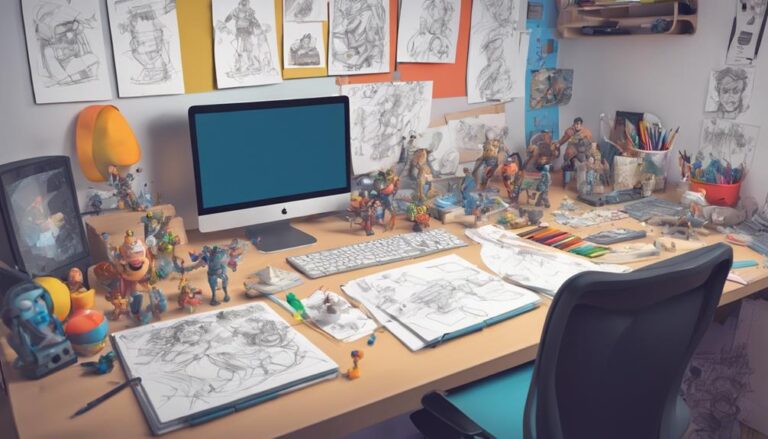5 Best Techniques for Realistic Textures in 3D CGI
When creating realistic textures in 3D CGI, you're likely no stranger to the frustration of falling short. You've spent hours perfecting your model, but the textures just don't quite live up to the real thing. It's time to take your skills to the next level by mastering the techniques that set pros apart. From gathering reference materials to simulating realistic wear and tear, there are five essential methods that can make all the difference. By applying these expert-approved strategies, you'll be able to craft textures that are virtually indistinguishable from reality – but where do you start?
Key Takeaways
- Reference real-world materials to create a material library, capturing surface details, textures, patterns, and colors through high-quality images or physical samples.
- Incorporate subtle noise and imperfections into textures using organic randomness, like Perlin or Simplex noise, to create a realistic appearance.
- Leverage advanced normal mapping techniques, such as normal map blending and frequency control, to create richly detailed, high-frequency details.
- Craft custom tileable textures that can be repeated indefinitely without visible seams or patterns, ensuring resolution is a power of two for optimization.
- Simulate realistic wear and tear using techniques like noise maps, gradient maps, and physics-based simulations to create a sense of history and usage on the surface.
Reference Real-World Materials
When creating realistic textures in 3D CGI, you'll need to gather reference materials from the real world to verify accuracy and authenticity.
This involves collecting high-quality images, videos, or even physical samples of the materials you want to replicate. By doing so, you'll be able to observe and document the intricate details of surfaces, from the way light interacts with them to the subtle imperfections that make them look realistic.
To build an exhaustive material library, focus on surface observations.
Study the textures, patterns, and colors of various materials, such as wood, metal, fabric, or stone. Take note of how they respond to different lighting conditions, and how their appearance changes when viewed from different angles.
You can use a camera or a smartphone to capture high-resolution images, or even create a physical mood board with samples of the materials.
Mastering Noise and Imperfections
You'll need to incorporate subtle noise and imperfections into your textures to create a truly realistic appearance, as even the most mundane surfaces in the real world rarely exhibit perfect uniformity.
To achieve this, you can utilize organic randomness to introduce subtle variations in your textures. One effective method is to use noise patterns, such as Perlin or Simplex noise, to add subtle grain patterns to your materials. This can help break up the uniformity of your textures and create a more natural, organic look.
When applying noise patterns, it's vital to balance the level of noise to avoid overwhelming the texture. Start with a low frequency and gradually increase it until you achieve the desired level of imperfection.
You can also use noise to simulate the natural wear and tear of materials, such as scratches, dents, or rust. By mastering the art of noise and imperfections, you'll be able to create textures that aren't only visually appealing but also convincingly realistic.
Advanced Normal Mapping Techniques
By leveraging advanced normal mapping techniques, designers can create richly detailed, high-frequency details that would be impractical or impossible to achieve with traditional texture mapping methods.
One such technique is normal map blending, which allows you to combine multiple normal maps into a single, cohesive texture. This enables you to create complex, layered details that would be difficult to achieve with a single normal map. For instance, you can blend a normal map for rough, rocky terrain with another for fine, sandy details, resulting in a highly realistic and varied texture.
Another key aspect of advanced normal mapping is detailed frequency control. By adjusting the frequency of your normal maps, you can fine-tune the level of detail in your textures.
This allows you to create textures with both broad, sweeping details and intricate, high-frequency nuances. By combining these techniques, you can create textures that aren't only visually stunning but also highly realistic and immersive.
With advanced normal mapping, you can take your textures to the next level, creating rich, detailed environments that draw the viewer in and refuse to let go.
Creating Custom Tileable Textures
To achieve seamless repetition and efficient texture usage, designers must master the art of creating custom tileable textures, which involves carefully crafting textures that can be repeated indefinitely without visible seams or patterns. This requires a deep understanding of texture resolution and how it affects the overall visual quality of your 3D model.
When creating custom tileable textures, consider the following essential factors:
Certify that your texture can be shifted and repeated seamlessly, without any visible patterns or discontinuities.
Use a texture resolution that's a power of two (e.g., 1024×1024, 2048×2048) to optimize texture sampling and minimize aliasing.
Create textures that are symmetrical or can be mirrored to reduce the amount of unique texture data needed.
Balance color and contrast to create a texture that blends seamlessly with its surroundings, rather than standing out as a repeating pattern.
Simulating Realistic Wear and Tear
With your custom tileable texture in place, it's now time to add the finishing touches by simulating realistic wear and tear, which can make all the difference in creating a truly immersive 3D environment.
To achieve this, you'll need to focus on two key aspects: friction patterns and material degradation.
Friction patterns can be simulated by adding subtle scratches, scuffs, and worn areas to your texture. You can achieve this by using noise maps, gradient maps, or even manually painting on the texture. The goal is to create a sense of history and usage on the surface, making it look like it's been interacted with in the real world.
Material degradation, on the other hand, involves simulating the natural breakdown of materials over time. This can include things like rust, corrosion, or fading. You can use techniques like ambient occlusion, specular mapping, or even physics-based simulations to create a more realistic look.
Frequently Asked Questions
How Do I Optimize Textures for Real-Time Rendering Without Sacrificing Quality?
When optimizing textures for real-time rendering, you'll want to leverage texture compression to reduce memory usage and employ mipmap optimization to minimize rendering overhead, ensuring high-quality visuals without sacrificing performance.
Can I Use 3D Scanning to Create Realistic Textures From Real-World Objects?
When scanning real-world objects for textures, you'll need to ponder scan resolution and object preparation to achieve high-quality results; prepare objects by cleaning and applying a matte finish, then capture detailed scans at high resolutions to guarantee accurate texture reproduction.
How Do I Create Textures That Work Well With Different Lighting Conditions?
You'll need to create textures that adapt to varying material responses and lighting scenarios; achieve this by using physically-based rendering (PBR) and capturing complex reflectance data to guarantee your textures hold up under diverse illumination conditions.
Are There Any Specific Software or Plugins Recommended for Texture Creation?
You'll find that software like Substance Painter and Quixel Suite excel in texture creation, offering robust material libraries and streamlined texture workflows that help you achieve consistent results across various lighting conditions.
How Do I Ensure Consistency in Texture Style Across a Large 3D Project?
To guarantee consistency in texture style across a large 3D project, you'll want to develop an exhaustive style guide, then implement an asset management system to track and enforce those guidelines throughout production.
Conclusion
You've now mastered the five essential techniques for achieving realistic textures in 3D CGI.
By collecting reference materials, mastering noise and imperfections, utilizing advanced normal mapping, crafting custom tileable textures, and simulating realistic wear and tear, you'll create immersive environments that transport audiences.
With these techniques, you'll add depth, authenticity, and visual interest to your 3D models, elevating your work to the next level of realism.






